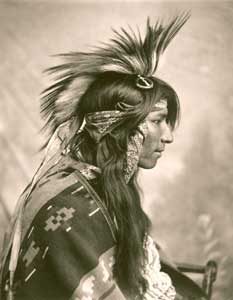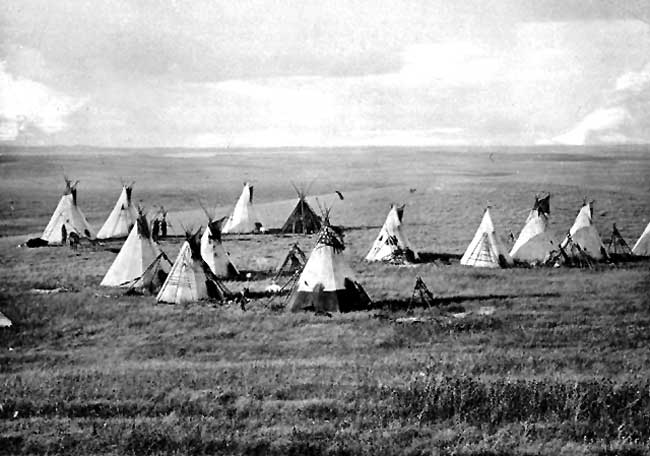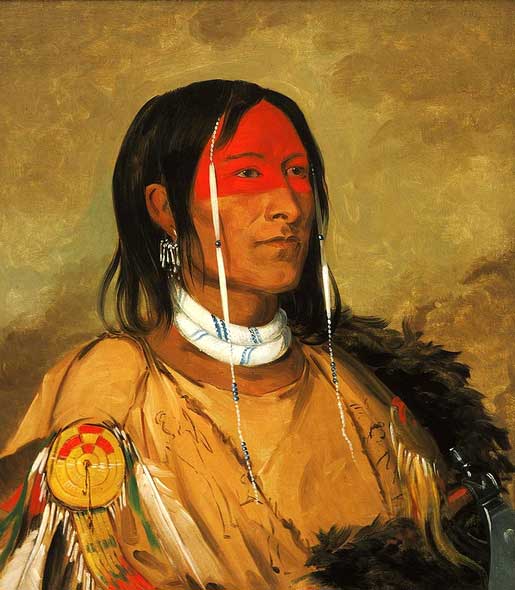One of the largest native groups in North America, the name “Cree” comes from “Kristineaux,” or “Kri” for short, a name given to them by French fur traders.
The Cree are indigenous people originally living in Manitoba, Canada. However, one branch later moved southwest to adopt a buffalo-hunting culture. This group, called the Plains Cree, lived from Lake Superior westward in northern Minnesota, North Dakota, and Montana.
Living as hunter-gatherers, the Cree people lived in lodges comprised of several groups who moved and hunted together. Within each lodge were several family groups of about 8-12 people who lived together in the same wigwam or tipi. Separate lodges were part of larger bands that could be easily formed and dissolved. In the case of disagreement, lodges could leave bands, but as there was safety in numbers, a departing lodge would quickly find another band to travel and dwell with. Various bands usually had ties to other neighboring bands through intermarriage, often assembled to hunt and socialize together. Though each band was independent, they sometimes joined together when facing outside enemies. If they went to war, the various bands would nominate a temporary military commander, called a okimahkan, which loosely translated as “war chief.”
The Cree were first contacted by Europeans in 1682, at the mouth of the Nelson and Hayes Rivers in northern Manitoba, Canada, by a Hudson’s Bay Company party traveling about 100 miles inland. Contact was made again with southern bands in 1732 in northwestern Ontario when Pierre Gaultier de Varennes met with an assembled group of 200 Cree warriors and members of the Monsoni tribe, a branch of the Ojibwe (Chippewa), near present-day Fort Frances. At that time, the Indian groups were wearing war paint and preparing to attack the Dakota Sioux and another group of Ojibwe Indians.
The Cree acquired firearms from the Hudson’s Bay Company, and many moved into the plains as middlemen with the fur trade company. Although warlike, the Cree were friendly to fur traders, and their history closely follows that of the Hudson’s Bay and North West fur companies. Many Cree people intermarried with the French and later Scottish settlers to form a mixed-blood people known as the Metis.
For many years, the influx of European settlers into America had little effect on the daily life of the Woodland Cree in northern Canada. However, the Plains Cree took on the “horse culture” of the Plains Indians and became bison hunters. Those Cree who moved onto the Great Plains and adopted bison hunting were allied with the Assiniboine and the Saulteaux in what was known as the “Iron Confederacy.” This group became a major force in the North American fur trade from the 1730s to the 1870s.
Over time, European settlers’ expansion and the buffalo herds’ loss forced the Plains Cree to move to reservations and take up farming. In Canada, the Metis and Cree fought the Canadian government forces when the building of the Canadian Pacific Railroad encroached upon their lands. Finally, in 1885 they were defeated.
Today, the Cree are one of the largest groups of First Nations in Canada, with over 350,000 people having Cree ancestry. Their language is one of the most widely used Indian languages. In the United States, most Cree people live mostly in Montana, where they share the Rocky Boy Indian Reservation with the Ojibwe people. Others live Fort Peck Indian Reservation and the Fort Belknap Indian Reservation, also in Montana.
The Rocky Boy Reservation, lying in the rolling foothills and plains of the Bear Paw Mountains in north-central Montana, encompasses approximately 128,000 acres. It is home to 55% of the approximately 6,500 enrolled Chippewa & Cree tribal members. The tribe calls themselves “Ne Hiyawak” which means “those who speak the same language.” The name “Rocky Boy” was derived from the name of a leader of a band of Chippewa Indians. The reservation’s economy is primarily supported by agriculture and livestock. The tribe celebrates Rocky Boy’s Pow Wow annually in August.
More Information:
The Chippewa Cree Tribe of the Rocky Boy Indian Reservation
PO Box 544
96 Clinic Road North
Box Elder, Montana 59521
406-395-5705
© Kathy Alexander/Legends of America, updated December 2022.
Also See:
Chippewa – People of the Great Lakes
Native American Heroes & Leaders
Native American Photo Galleries
Native Americans – The First Owners of America
Sources:



